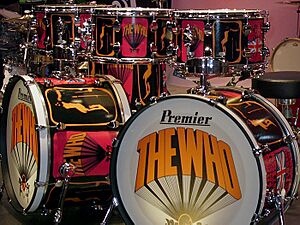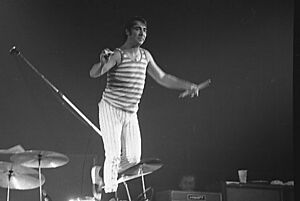Keith Moon facts for kids
Quick facts for kids
Keith Moon
|
|
|---|---|

Moon in 1975
|
|
| Born |
Keith John Moon
23 August 1946 |
| Died | 7 September 1978 (aged 32) Mayfair, London, England
|
| Resting place | Golders Green Crematorium, London, England |
| Occupation |
Musician
|
| Spouse(s) |
Kim Kerrigan
(m. 1966; div. 1975) |
| Partner(s) | Annette Walter-Lax (1975–1978) |
| Children | 1 |
| Musical career | |
| Genres | |
| Instruments |
|
| Years active | 1962–1978 |
Keith John Moon (23 August 1946 – 7 September 1978) was an English musician who was the drummer for the rock band the Who. Regarded as one of the greatest drummers in the history of rock music, he was noted for his unique style of playing and his eccentric, often self-destructive behaviour.
Moon grew up in Wembley and took up the drums during the early 1960s. After playing with a local band, the Beachcombers, he joined the Who in 1964 before they recorded their first single. Moon was recognised for his drumming style, which emphasised tom-toms, cymbal crashes, and drum fills. Throughout his tenure with the Who, his drum kit steadily grew in size, and (along with Ginger Baker) he has been credited as one of the earliest rock drummers to regularly employ double bass drums in his setup. Moon occasionally collaborated with other musicians and later appeared in films, but considered playing in the Who his primary occupation, and remained a member of the band until his death. In addition to his talent as a drummer, Moon developed a reputation for smashing his kit on stage and destroying hotel rooms on tour. He was fascinated with blowing up toilets with cherry bombs or dynamite, and destroying television sets. Moon also enjoyed touring and socialising, and became bored and restless when the Who were inactive. His 21st birthday party in Flint, Michigan, has been cited as a notorious example of decadent behaviour by rock groups.
Moon suffered a number of setbacks during the 1970s, most notably the accidental death of chauffeur Neil Boland and the breakdown of his marriage. He acquired a reputation for decadence and dark humour; his nickname was "Moon the Loon". While touring with the Who, on several occasions he passed out on stage and was hospitalised. By the time of their final tour with him in 1976, and particularly during production of The Kids Are Alright and Who Are You, the drummer's deterioration was evident. Moon moved back to London from Los Angeles in 1978, dying that September.
Moon's drumming continues to be praised by critics and musicians. He was posthumously inducted into the Modern Drummer Hall of Fame in 1982, becoming the second rock drummer to be chosen, and in 2011 he was voted the second-greatest drummer in history by a Rolling Stone readers' poll. Moon was inducted into the Rock and Roll Hall of Fame in 1990 as a member of the Who.
Contents
Early life
Keith John Moon was born to Alfred Charles (Alf) and Kathleen Winifred (Kit) Moon on 23 August 1946 at Central Middlesex Hospital in northwest London; he grew up in Wembley. Moon was hyperactive as a boy, with a restless imagination and a particular fondness for music and The Goon Show. Moon attended Alperton Secondary Modern School after failing his eleven plus exam, which precluded his attending a grammar school. His music teacher wrote that Moon "has great ability, but must guard against a tendency to show off."
Moon joined his local Sea Cadet Corps band at the age of twelve on the bugle, but found the instrument too difficult to learn and decided to take up drums instead. He was interested in practical jokes and home science kits, with a particular fondness for explosions. On his way home from school, Moon would often go to Macari's Music Studio on Ealing Road to practise on the drums there, learning his basic skills on the instrument. He left school around Easter 1961, at age 14. Moon then enrolled at Harrow Technical College; this led to a job as a radio repairman, enabling him to buy his first drum kit.
Career
Early years
Moon took lessons from one of the loudest contemporary drummers, Screaming Lord Sutch's Carlo Little, at ten shillings per lesson. His early style was influenced by jazz, American surf music and rhythm and blues, exemplified by noted Los Angeles studio drummer Hal Blaine. His favourite musicians were jazz artists, particularly Gene Krupa (whose flamboyant style he subsequently copied). He also admired Elvis Presley's original drummer DJ Fontana, The Shadows' original drummer Tony Meehan and the Pretty Things' Viv Prince. Moon also enjoyed singing, with a particular interest in Motown. Moon idolised the Beach Boys; Roger Daltrey later said that given the opportunity, Moon would have left to play for the California band even at the peak of the Who's fame.
During this time Moon joined his first serious band, the Escorts, replacing his best friend Gerry Evans. In December 1962 he joined the Beachcombers, a semi-professional London cover band playing hits by groups such as The Shadows. During his time in the group Moon incorporated theatrical tricks into his act, including "shooting" the group's lead singer with a starter pistol. The Beachcombers all had day jobs; Moon, who worked in the sales department at British Gypsum, had the keenest interest in turning professional. In April 1964, aged 17, he auditioned for the Who as a replacement for Doug Sandom. The Beachcombers continued as a local cover band after his departure.
The Who
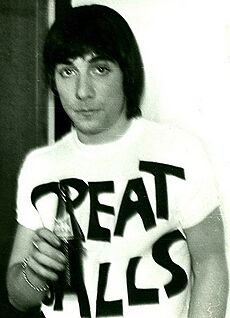
A commonly cited story of how Moon joined the Who is that he appeared at a show shortly after Sandom's departure, where a session drummer was used. Dressed in ginger clothes and with his hair dyed ginger (future bandmate Pete Townshend later described him as a "ginger vision"), he claimed to his would-be bandmates that he could play better; he played in the set's second half, nearly demolishing the drum kit in the process.
As Moon later recounted: "[T]hey said go ahead, and I got behind this other guy's drums and did one song—'Road Runner.' I'd several drinks to get me courage up and when I got onstage I went arrgggGhhhh on the drums, broke the bass drum pedal and two skins, and got off. I figured that was it. I was scared to death. Afterwards I was sitting at the bar and Pete came over. He said: 'You ... come 'ere.' I said, mild as you please: 'Yes, yes?' And Roger, who was the spokesman then, said: 'What are you doing next Monday?' I said: 'Nothing.' I was working during the day, selling plaster. He said: 'You'll have to give up work ... there's this gig on Monday. If you want to come, we'll pick you up in the van.' I said: 'Right.' And that was it." Moon later claimed that he was never formally invited to join the Who permanently; when Ringo Starr asked how he had joined the band, he said he had "just been filling in for the last fifteen years."
Moon's arrival in the Who changed the dynamics of the group. Sandom had generally been the peacemaker as Daltrey and Townshend feuded between themselves, but because of Moon's temperament the group now had four members frequently in conflict. "We used to fight regularly", remembered Moon in later years. "John [Entwistle] and I used to have fights—it wasn't very serious, it was more of an emotional spur-of-the moment thing." Moon also clashed with Daltrey and Townshend: "We really have absolutely nothing in common apart from music", he said in a later interview. Although Townshend described him as a "completely different person to anyone I've ever met", the pair had a rapport in the early years and enjoyed practical jokes and improvised comedy. Moon's drumming style affected the band's musical structure; although Entwistle initially found Moon's lack of conventional timekeeping problematic, it created an original sound.
Moon was particularly fond of touring since it was his only chance to regularly socialise with his bandmates, and was generally restless and bored when not playing live. This later carried over to other aspects of his life, as he acted them out (according to journalist and Who biographer Dave Marsh) "as if his life were one long tour." These antics earned him the nickname "Moon the Loon".
Musical contributions
Moon's style of drumming was considered unique by his bandmates, although they sometimes found his unconventional playing frustrating; Entwistle noted that he tended to play faster or slower according to his mood. "He wouldn't play across his kit", he later added. "He'd play zig-zag. That's why he had two sets of tom-toms. He'd move his arms forward like a skier." Daltrey said that Moon "just instinctively put drum fills in places that other people would never have thought of putting them."
Who biographer John Atkins wrote that the group's early test sessions for Pye Records in 1964 show that "they seemed to have understood just how important was ... Moon's contribution." Contemporary critics questioned his ability to keep time, with biographer Tony Fletcher suggesting that the timing on Tommy was "all over the place." Who producer Jon Astley said, "You didn't think he was keeping time, but he was." In the opinion of Atkins, early recordings of Moon's drumming sound tinny and disorganised; it was not until the recording of Who's Next, with Glyn Johns' no-nonsense production techniques and the need to keep time to a synthesizer track, that Moon began developing more discipline in the studio. Fletcher considers the drumming on this album to be the best of Moon's career.
Unlike contemporary rock drummers such as Ginger Baker and John Bonham, Moon hated drum solos and refused to play them in concert. At a Madison Square Garden show during The Who's 1974 tour, Townshend and Entwistle decided to spontaneously stop playing during "Waspman" to listen to Moon's drum solo. Moon continued briefly and then stopped, shouting, "Drum solos are boring!" On 23 June 1977, he made a guest appearance at a Led Zeppelin concert in Los Angeles.

Moon also aspired to sing lead vocal on some songs. While the other three members handled most of the onstage vocals, Moon would attempt to sing backup (particularly on "I Can't Explain"). He provided humorous commentary during song announcements, although sound engineer Bob Pridden preferred to mute his vocal microphone on the mixing desk whenever possible. Moon's knack for making his bandmates laugh around the microphone led them to banish him from the studio when vocals were being recorded; this led to a game in which Moon would sneak in to join the singing. At the end of "Happy Jack", Townshend can be heard saying, "I saw ya!" to Moon as he tries to sneak into the studio. The drummer's interest in surf music and his desire to sing led to his performing lead vocals on several early tracks, including "Bucket T" and "Barbara Ann" (Ready Steady Who EP, 1966) and high backing vocals on other songs, such as "Pictures of Lily". His performance on "Bell Boy" (Quadrophenia, 1973) saw him abandon "serious" vocal performances to sing in character; it was "exactly the kind of performance the Who needed from him to bring them back down to earth."
Moon composed "I Need You", the instrumental "Cobwebs and Strange" (from the album A Quick One, 1966), the single B-sides "In The City" (co-written with Entwistle) and "Girl's Eyes" (from The Who Sell Out sessions featured on Thirty Years of Maximum R&B and a 1995 re-release of The Who Sell Out), "Dogs Part Two" (1969) and "Waspman" (1972). Moon also co-composed "The Ox" (an instrumental from their debut album, My Generation) with Townshend, Entwistle and keyboardist Nicky Hopkins. "Tommy's Holiday Camp" (from Tommy) was credited to Moon because he came up with the idea, but the song was actually written by Townshend and, although there is a misconception that Moon sings on it, the album version is Townshend's demo.
Moon produced the violin solo on "Baba O'Riley". Moon sat in on congas with East of Eden at London's Lyceum Ballroom, and afterwards suggested to violinist Dave Arbus that he play on the track.
Equipment
Moon played a four- and later a five-piece drum kit during his early career. During much of 1964 and 1965 his setups consisted of Ludwig drums and Zildjian cymbals. He began to endorse Premier Drums in late 1965 and remained a loyal customer of the company. His first Premier kit was in red sparkle and featured two high toms. In 1966, Moon moved to an even larger kit, but without the customary hi-hat—at the time he preferred keeping ride rhythms with ride and crash cymbals, but he later reinstated the hi-hats. His new larger configuration was notable for the presence of two bass drums; he, along with Ginger Baker, has been credited as one of the early pioneers of double bass drumming in rock. This kit was not used at the Who's performance at the 1967 Monterey Pop Festival. From 1967 to 1969, Moon used the "Pictures of Lily" drum kit (named for its artwork), which had two 22-inch (56 cm) bass drums, two 16-inch (41 cm) floor toms and three mounted toms. In recognition of his loyalty to the company, Premier reissued the kit in 2006 as the "Spirit of Lily".
By 1970, Moon had begun to use timbales, gongs and timpani, and these were included in his setup for the rest of his career. In 1973, Premier's marketing manager, Eddie Haynes, began consulting Moon about specific requirements. At one point, Moon asked Premier to make a white kit with gold-plated fittings. When Haynes said that it would be prohibitively expensive, Moon replied: "Dear boy, do exactly as you feel it should be, but that's the way I want it." The kit was eventually fitted with copper fittings and later given to a young Zak Starkey.
Destroying instruments and other stunts
At an early show at the Railway Tavern in Harrow, Townshend smashed his guitar after accidentally breaking it. When the audience demanded he do it again, Moon kicked over his drum kit. Subsequent live sets culminated in what the band later described as "auto-destructive art", in which band members (particularly Moon and Townshend) elaborately destroyed their equipment. Moon developed a habit of kicking over his drums, claiming that he did so in exasperation at an audience's indifference. Townshend later said, "A set of skins is about $300 [then £96] and after every show he'd just go bang, bang, bang and then kick the whole thing over."
In May 1966, Moon discovered that the Beach Boys' Bruce Johnston was visiting London. After the pair socialised for a few days, Moon and Entwistle brought Johnston to the set of Ready Steady Go!, which made them late for a show with the Who that evening. During the finale of "My Generation", an altercation broke out on stage between Moon and Townshend which was reported on the front page of the New Musical Express the following week. Moon and Entwistle left the Who for a week (with Moon hoping to join the Animals or the Nashville Teens), but they changed their minds and returned.
On the Who's early US package tour at the RKO 58th Street Theatre in New York in March and April 1967, Moon performed two or three shows a day, kicking over his drum kit after every show. Later that year, during their appearance on The Smothers Brothers Comedy Hour, he bribed a stagehand to load gunpowder into one of his bass drums; the stagehand used about ten times the standard amount. During the finale of "My Generation", he set off the charge. The intensity of the explosion singed Townshend's hair and embedded a piece of cymbal in Moon's arm. A clip of the incident became the opening scene for the film The Kids Are Alright.
Although Moon was known for kicking over his drum kit, Haynes claimed that it was done carefully and the kit rarely needed repairs. However, stands and foot pedals were frequently replaced; the drummer "would go through them like a knife through butter".
Other work
Music
While Moon generally said he was only interested in working with the Who, he participated in outside musical projects. In 1966, he worked with Yardbirds guitarist Jeff Beck, pianist Nicky Hopkins and future Led Zeppelin members Jimmy Page and John Paul Jones on the instrumental "Beck's Bolero", which was the B-side to "Hi Ho Silver Lining" and appeared on the album Truth. Moon also played timpani on another track, a cover of Jerome Kern's "Ol' Man River". He was credited on the album as "You Know Who".
Moon may have inspired the name for Led Zeppelin when he supposedly briefly considered leaving the Who in 1966 and spoke with Entwistle and Page about forming a supergroup; Moon (or Entwistle) remarked that a particular suggestion had gone down like a "lead zeppelin" (a play on "lead balloon"). Although this supergroup was never formed, Page remembered the phrase and later adapted it as the name of his new band.
The Beatles became friends with Moon, and this led to occasional collaborations. In 1967, he contributed backing vocals to "All You Need Is Love". On 15 December 1969, Moon joined John Lennon's Plastic Ono Band for a live performance at the Lyceum Theatre in London for a UNICEF charity concert. In 1972, the performance was released as a companion disc to Lennon and Ono's album Some Time in New York City.
Moon's friendship with Entwistle led to an appearance on Smash Your Head Against the Wall, Entwistle's first solo album and the first by a member of the Who. Moon did not play drums on the album; Jerry Shirley did, with Moon providing percussion. Rolling Stone's John Hoegel appreciated Entwistle's decision not to let Moon drum, saying that it distanced his album from the familiar sound of the Who.
Moon became involved in solo work when he moved to Los Angeles during the mid-1970s. Track Records-MCA released a Moon solo single in 1974, comprising cover versions of the Beach Boys' "Don't Worry, Baby" and "Teenage Idol". The following year he released his only solo album, entitled Two Sides of the Moon. Although it featured Moon on vocals, he played drums on only three tracks; most of the drumming was left to others (including Ringo Starr, session musicians Curly Smith and Jim Keltner, and actor-musician Miguel Ferrer). The album was received poorly by critics. New Musical Express's Roy Carr wrote, "Moonie, if you didn't have talent, I wouldn't care; but you have, which is why I'm not about to accept Two Sides of the Moon." Dave Marsh, reviewing the album in Rolling Stone, wrote: "There isn't any legitimate reason for this album's existence." During one of his few televised solo drum performances (for ABC's Wide World), Moon played a five-minute drum solo dressed as a cat on transparent acrylic drums filled with water and goldfish. When asked by an audience member what would happen to the kit, he joked that "even the best drummers get hungry." His performance was not appreciated by animal lovers, several of whom called the station with complaints.
Film
In the 2007 documentary film Amazing Journey: The Story of The Who, Daltrey and Townshend reminisced about Moon's talent for dressing as (and embodying) a variety of characters. They remembered his dream of getting out of music and becoming a Hollywood film actor, although Daltrey did not think Moon had the patience and work ethic required of a professional actor. Who manager Bill Curbishley agreed that Moon "wasn't disciplined enough to actually turn up or commit to doing the stuff."
Nevertheless, the drummer landed several acting roles. His first was in 1971, a cameo in Frank Zappa's 200 Motels as a nun. Although it only took 13 days to film, fellow cast member Howard Kaylan remembers Moon spending off-camera time at the Kensington Garden Hotel bar instead of sleeping. Moon's next film role was J.D. Clover, drummer for the fictional Stormy Tempest (played by Billy Fury) at a holiday camp during the early days of British rock 'n' roll, in 1973's That'll Be the Day. He reprised the role for the film's 1974 sequel, Stardust, in Jim MacLaine's (David Essex) backing band the Stray Cats and played Uncle Ernie in Ken Russell's 1975 film adaptation of Tommy. Moon's last film appearance was in 1978's Sextette.
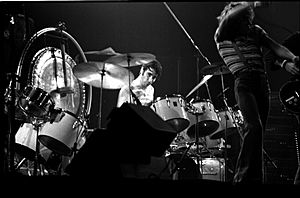
Financial problems
Because the Who's early stage act relied on smashing instruments and owing to Moon's enthusiasm for damaging hotels, the group were in debt for much of the 1960s; Entwistle estimated they lost about £150,000. Even when the group became relatively financially stable after Tommy, Moon continued to rack up debts. He bought a number of cars and gadgets and flirted with bankruptcy. Moon's recklessness with money reduced his profit from the group's 1975 UK tour to £47.35 (equivalent to £286 in 2021).
Personal life and relationships
Birthdate
Before the 1998 release of Tony Fletcher's Dear Boy: The Life of Keith Moon, Moon's date of birth was presumed to be 23 August 1947. This erroneous date appeared in several otherwise-reliable sources, including the Townshend-authorised biography Before I Get Old: The Story of The Who. The incorrect date had been supplied by Moon in interviews before it was corrected by Fletcher to 1946.
Kim Kerrigan
Moon's first serious relationship was with Kim Kerrigan, whom he started dating in January 1965 after she saw the Who play at Le Disque a Go! Go! in Bournemouth. By the end of the year she discovered she was pregnant. Her parents, who were furious, met with the Moons to discuss their options, and she moved into the Moon family home in Wembley. She and Moon were married on 17 March 1966 at Brent Register Office, and their daughter Amanda was born on 12 July. The marriage (and child) were kept secret from the press until May 1968. He loved Amanda, but his absences due to touring and fondness for practical jokes made their relationship uneasy when she was very young. "He had no idea how to be a father", Kim said. "He was too much of a child himself."
From 1971 to 1975 Moon owned Tara, a home in Chertsey where he initially lived with his wife and daughter. The Moons entertained extravagantly at home, and owned a number of cars. Jack McCullogh, then working for Track Records (the Who's label), recalls Moon ordering him to purchase a milk float to store in the garage at Tara.
In 1973 Kim, convinced that neither she nor anyone else could moderate Keith's behaviour, left her husband and took Amanda; she sued for divorce in 1975 and later married Faces keyboard player Ian McLagan. Marsh believes that Moon never truly recovered from the loss of his family. Butler agrees; despite his relationship with Annette Walter-Lax, he believes that Kim was the only woman Moon loved. McLagan commented that Moon "couldn't handle it." Moon would harass them with phone calls, and on one occasion before Kim sued for divorce, he invited McLagan for a drink at a Richmond pub and sent several "heavies" to break into McLagan's home on Fife Road and look for Kim, forcing her to hide in a walk-in closet. She died in a car accident in Austin, Texas, on 2 August 2006.
Death
Moon was found dead in his flat at 9 Curzon Place (later Curzon Square), Shepherd Market, Mayfair, London. Moon was cremated on 13 September 1978 at Golders Green Crematorium in London, and his ashes were scattered in its Gardens of Remembrance.
Legacy
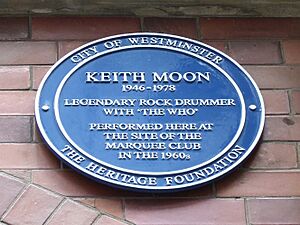
Moon's drumming has been praised by critics. Author Nick Talevski described him as "the greatest drummer in rock", adding that "he was to the drums what Jimi Hendrix was to the guitar." Holly George-Warren, editor and author of The Rock and Roll Hall of Fame: The First 25 Years, said: "With the death of Keith Moon in 1978, rock arguably lost its single greatest drummer."
Several rock drummers, including Neil Peart have cited Moon as an influence. The Jam paid homage to Moon on the second single from their third album, "Down in the Tube Station at Midnight"; the B-side of the single is a Who cover ("So Sad About Us"), and the back cover of the record has a photo of Moon's face. The Jam's single was released about a month after Moon's death. Animal, one of Jim Henson's Muppet characters, may have been based on Keith Moon due to their similar hair, eyebrows, personality and drumming style. Jazz drummer Elvin Jones praised Moon's work during "Underture", as integral to the song's effect.
Ray Davies notably lauded Moon's drumming during his speech for the Kinks' induction into the Rock and Roll Hall of Fame, in 1990: "... Keith Moon changed the sound of drumming."
Clem Burke of Blondie has said "Early on all I cared about was Keith Moon and the Who. When I was about eleven or twelve, my favourite part of drum lessons was the last ten minutes, when I'd get to sit at the drumset and play along to my favourite record. I'd bring in 'My Generation'. At the end of the song, the drums go nuts. 'My Generation' was a turning point for me because before that it was all the Charlie Watts and Ringo type of thing."
In 1998 Tony Fletcher published a biography of Moon, Dear Boy: The Life of Keith Moon, in the United Kingdom. The phrase "Dear Boy" became a catchphrase of Moon's when, influenced by Kit Lambert, he began affecting a pompous English accent. In 2000, the book was released in the US as Moon (The Life and Death of a Rock Legend). Q Magazine called the book "horrific and terrific reading", and Record Collector said it was "one of rock's great biographies."
Discography
- Solo albums
- Two Sides of the Moon (1975)
Other appearances
- "When I'm Sixty-Four" for All This and World War II (1976)
See also
 In Spanish: Keith Moon para niños
In Spanish: Keith Moon para niños



